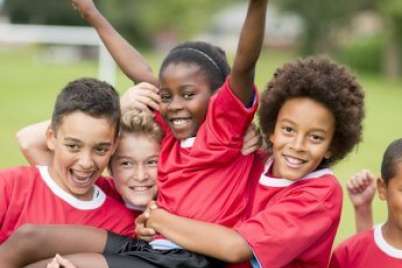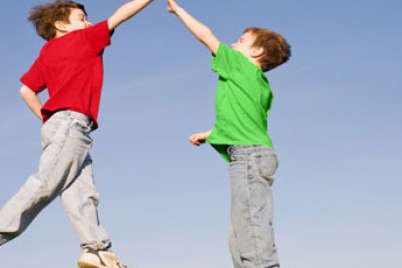
Questions to ask your child’s phys ed teacher
Last week, a reader on my Facebook page who is not an educator asked for examples of questions to ask a PE teacher on parents’ night. I was pumped. It’s so important for parents to be health advocates for their child – at home and at school.
Picking and choosing some of the following questions might help you learn more about your child’s physical education experience. Yet, the list is far from exhaustive. I could write a separate post related to active transportation and appropriate levels of screen time, for example.
Without further ado, here are some helpful questions for parents to ask. Beneath each question are additional comments that I felt necessary to include.
I encourage you to make time to visit your child’s PE teacher and to support their physical literacy journey.
Guest post by Amanda Stanec
Dr. Amanda Stanec is the founder of Move Live Learn, where this article first appeared. A TrueSport Ambassador, Amanda is a physical education, sport, and physical literacy coach and consultant. She is also a wife, mom, speaker, runner, and yoga instructor.
What physical skills and skill combinations are being taught, and how can I reinforce them at home?
The ideal response will depend on age and development level. It’s important that children are taught the fundamental movements and that they begin to combine the movements in Grades 2 to 4. During the later elementary years, students should be applying these skill combinations in more complex ways. As much as possible, these skills are taught through authentic (real-life settings) practice to increase fun and opportunity to gain skills.
How do you assess students, and how often do you assess them?
Ideally, you will hear words like “formative daily assessment”. This refers to ongoing assessment, and is used by teachers to give students skill-specific feedback on maintaining or improving skills. Students should always know they are being assessed and should know what the teacher is looking for them to demonstrate.
Are you assessing all learning domains: physical, cognitive, and affective?
Physical education is a class where the whole child is considered and nurtured. This includes not only what they can demonstrate in the physical domain, but also if they know how to transfer the skills and knowledge to their life outside of school. Additionally, skills such as effective collaboration, communication, and risk-taking are taught and assessed in a solid PE program.
Do you teach sports as their own entity or small-sided modified versions of sport?
It is a very traditional mindset to teach adult versions of sports in a PE program. But this simply doesn’t belong. Too few students have the opportunity to develop skills when this is the case. Instead, students should experience small-side, modified versions of sport. This version could be presented within an instructional model such as Teaching Games for Understanding (TGfU).
What is the balance of activities that you use to teach skills and understanding between dance, games, gymnastics, and other pursuits?
Individual curriculum will determine mandates around categories of activities, but traditional programs place far too much emphasis on games than the other categories. It is important that students gain skills in a variety of activities to increase their skills as well as increase the likeliness that each student finds an activity that she/he loves.
Is my child positive and effective in collaborating with others? What successes or areas for improvement do you suggest I talk to her/him about related to teamwork?
Collaborating and teamwork are important life skills. Physical activity environments present a unique way to teach these skills. Ask the teacher about these skills and how you can practice and model them within your family unit.
Will students be exposed to skill development on a variety of surfaces (land, snow, ice, and water) to best support their physical literacy development?
Physical education isn’t called gym class (at least it shouldn’t be anymore) and there are many reasons for this. A gymnasium is one space in which PE is taught. But, if only taught in this one space, think about how many skills aren’t taught. Skating, surfing, swimming, snowshoeing, orienteering, geocaching, hiking, biking … the list goes on. If you want to increase skill offerings in your child’s school, see how you might be able to rally up some other parents who can make it happen. I have observed first hand the power of an inspired group of parents at the school level.
If my child is excelling or struggling, how are you differentiating your teaching to meet his/her needs?
We all learn differently and we all bring strengths and weakness to experiences. It’s important to understand how your child’s needs are being met. Ideally, you can share some tips that work for you and gain some insight on what is working well for the teacher. Either way, the child wins.
Do you work with classroom teachers to weave classroom content into PE lessons? If so, how are you doing that?
I find that teaching PE lessons with classroom content makes classes more relevant to students, and they feel I have superpowers because I know what they are up to when they aren’t on my watch. It’s fun to plan in an interdisciplinary way, and it’s fun to teach in this way. A PE teacher shouldn’t do this in lieu of the PE content, she/he should teach this way in an effort to make learning more meaningful for students.
How are students required to demonstrate that they understand why this content is important? How do they put it into action?
It’s one thing to teach students a skill, it’s another – better – thing to teach them how to use it in multiple ways and why to use it in multiple ways when they are not in PE class. Empowering students to put understanding into action will only make the world a better place.





